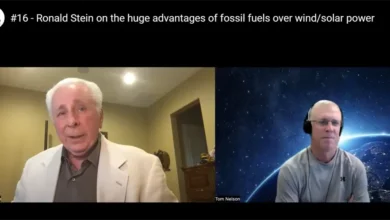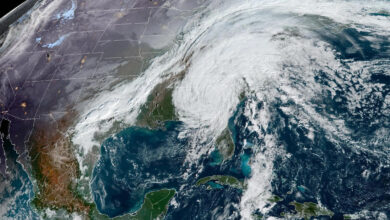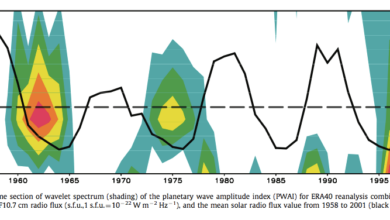Good Science Meets Science Journalism in the Gulf of Mexico – Watts Up With That?
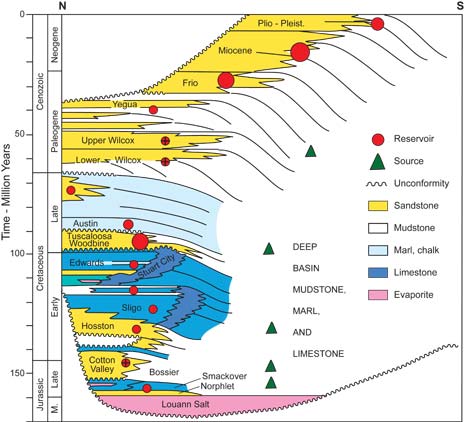
Guest “Oy vey!” by David Middleton
4 June 2022
Qamariya Nasrullah
How ancient ocean life in the Gulf of Mexico escaped mass extinction
The geology of the sheltered basin helped protect life against global warming.A bout of global warming 56 million years ago acidified oceans and wiped out marine life. But in the Gulf of Mexico, the effect was much milder. Research on the unique geology of this North American basin has revealed how life was able to escape local extinction.
The Palaeocene-Eocene Thermal Maximum (PETM) was a brief period of global warming, which saw a 5°C to 8°C spike in temperature and caused large changes in ocean chemistry. This caused a severe deep-sea benthic foraminifera extinction, known as the Benthic Extinction Event (BEE).
“This event, known as the Paleocene-Eocene Thermal Maximum, or PETM, is very important to understand because it’s pointing towards a very powerful, albeit brief, injection of carbon into the atmosphere that’s akin to what’s happening now,” says lead author Dr Bob Cunningham, from the University of Texas, US.
New research, published in Marine and Petroleum Geology, explores the biological responses during this geological time period, including the mud, sand and limestone deposits found across the Gulf of Mexico. Sifting through rock chips brought up during oil and gas drilling across 25 sites, the researchers found an abundance of fossilised radiolarians – a type of plankton – that appeared to survive, and even thrive, during a time when other ocean organisms were being wiped out.
[…]
“How ancient ocean life in the Gulf of Mexico escaped mass extinction”
The PETM was not a “mass extinction”. For that matter, benthic foraminifera actually recovered from “extinction”…
Palaeogeography, Palaeoclimatology, Palaeoecology 279 (2009) 186–200.
Extinction and recovery of benthic foraminifera across the Paleocene–Eocene Thermal Maximum at the Alamedilla section (Southern Spain)
L. Alegret , S. Ortiz E., Molina
A b s t r a c t
A complete succession of lower bathyal–upper abyssal sediments was deposited across the Paleocene–Eocene Thermal Maximum (PETM) at Alamedilla (Betic Cordillera, Southern Spain), where the benthic foraminiferal turnover and extinction event associated with the negative carbon isotope excursion (CIE) across the PETM have been investigated. Detailed quantitative analyses of benthic foraminifera allowed us to distinguish assemblages with paleoecological and paleoenvironmental significance: pre extinction fauna, extinction fauna, survival fauna (including disaster and opportunistic fauna) and recovery fauna. These assemblages have been associated with significant parts of the δ13C curve for which a relative chronology has been established. The correlation between the benthic turnover, the δ13C curve, the calcite and silicate mineral content, and sedimentation rates, allowed us to establish the sequence of events across the PETM. At Alamedilla, the benthic extinction event (BEE) affected ~37% of the species and it has been recorded over a 30-cm-thick interval that was deposited in c.a. 10 ky, suggesting a gradual but rapid pattern of extinction. The beginning of the BEE coincides with the onset of the CIE (+0 ky) and with an interval with abundant calcite, and it has been recorded under oxic conditions at the seafloor (as inferred from the benthic foraminiferal assemblages and the reddish colour of the sediments). We conclude that dissolution and dysoxia were not the cause of the extinctions, which were probably related to intense warming that occurred before the onset of the CIE.
The BEE is immediately overlain by a survival interval dominated by agglutinated species (the Glomospira Acme). The low calcite content recorded within the survival interval may result from the interaction between dilution of the carbonate compounds by silicicate minerals (as inferred from the increased sedimentation rates), and the effects of carbonate dissolution triggered by the shoaling of the CCD. We suggest that Glomospira species (disaster fauna) may have bloomed opportunistically in areas with methane dissociation, in and around the North Atlantic. The disaster fauna was rapidly replaced by opportunistic taxa, which point to oxic and, possibly, oligotrophic conditions at the seafloor. The CCD gradually dropped during this interval, and calcite preservation improved towards the recovery interval, during which the δ13C values and the calcite content recovered (c.a. +71.25 to 94.23 ky) and stabilized (N94.23 ky), coeval with a sharp decrease in sedimentation rates.
Benthic foram’s appear to have an even higher recovery rate from extinction than the Incilius genus of toads…

The shoaling (shallowing) of the lysocline during the PETM is represented by the 30 cm thick band of red clay from 13.4 to 13.7 m on the lithology column in figure 1. When the lysocline and carbonate compensation depth (CCD) briefly shoaled, the transition from calcareous to siliceous ooze moved shoreward. When the CCD dropped back down to its pre-PETM depth, the transition from calcareous to siliceous ooze moved seaward… Leaving a 30 cm thick layer of red clay in the middle of a thick marl sequence. Rising and falling sea levels also could have caused the deposition of a similar layer of red clay.
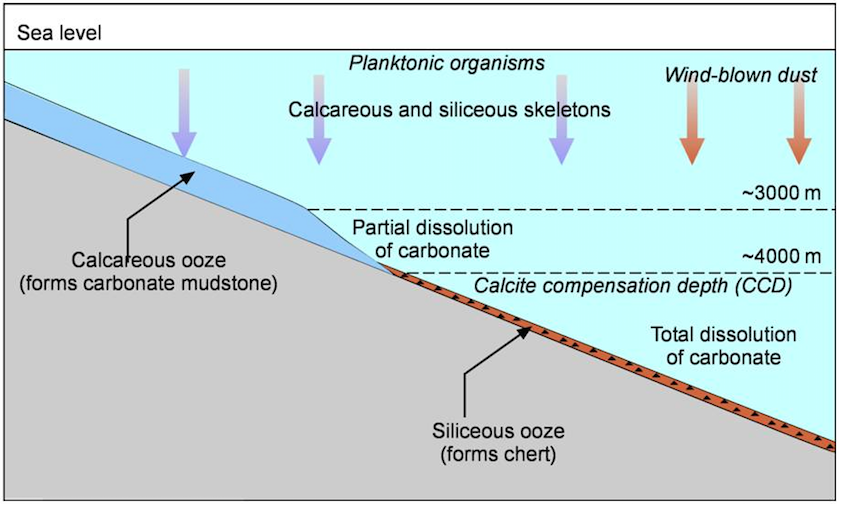


The benthic foram’s above and below the red clay horizon ceased to exist at that location for about 70,000 to 220,000 years. However, the fact that at least some of them returned to that location after the PETM might indicate that the benthic foram “mass extinction” was more of a benthic foram depositional “mass relocation,” rather than a true extinction.
“The geology of the sheltered basin helped protect life against global warming”
The short answer is: No, it didn’t.
The Cosmos article is supposedly about this paper:
Productivity and organic carbon trends through the Wilcox Group in the deep Gulf of Mexico: Evidence for ventilation during the Paleocene-Eocene Thermal Maximum
Robert Cunninghamab, Marcie Purkey Phillipsb, John W. Sneddenb, Ian O.Nortonb, Christopher M.Loweryb, Jon W.Virdellb, Craig D.Barriec, Aaron Averyd
a. ChargeSearch, Llano, TX, 78743, USA
b. The University of Texas at Austin, Institute of Geophysics, Austin, TX, 78712, USA
c. GeoMark Research, Houston, TX, 77095, USA
d. Paleo Data Inc., New Orleans, LA, 70124, USAHighlights
• PETM identified in deep-water Wilcox Gp across the northern Gulf of Mexico (GoM).• Calcareous nannofossil shift to oligotrophy and loss of benthic foraminifera mark PETM.
• Radiolarian bursts during and after PETM driven by runoff-enhanced nutrient supply.
• TOC in Wilcox Gp and PETM <3% in deep basin versus >3% in restricted margin settings.
• Biotic and geochemical responses indicate GoM was open and ventilated through PETM.
[…]
1. Introduction
During the Paleocene and Eocene greenhouse, deposition in the Gulf of Mexico (GoM) basin led to economically important petroleum-bearing deltaic and deep-water sands, coal resources, and petroleum source rocks hosted in the Wilcox Group (Gp). Tremendous industry focus has helped constrain the distribution and properties of these deposits, but paleoclimatic and paleoceanographic processes operating during deposition, especially in the deep-water GoM, are less clear. Of particular importance is unraveling the impacts of Laramide uplift, the Paleocene-Eocene Thermal Maximum (PETM), and restriction of the GoM due to the collision of the Cuban arc with Yucatan-Bahamas-Florida.
Paleogene global warming enhanced the hydrological feedbacks of chemical and physical weathering which combined with Laramide uplift of the Rocky Mountains to enhance fluvial runoff and sediment supply (Foreman et al., 2012; Kraus et al., 2015; Hessler et al., 2017). Massive coal deposits associated with paralic and delta systems of the paleo-Mississippi, Brazos, Colorado, and Rio Grande Rivers form the largest lignite producing region in the United States (Fig. 1; EIA, 2017). They contribute to a peak in global terrestrial organic matter deposition and Paleocene carbon isotope maximum (Dyni, 2003; Kurtz et al., 2003; Littler et al., 2014). Source beds for a petroleum system extending from the coastal plain into deep water containing terrestrial and marine organic matter were deposited in deltaic to submarine fan environments of the Wilcox Gp (McDade, 1992; McDade et al., 1993; Hood et al., 2002; Ferworn et al., 2003; Holguin-Quinones et al., 2005).
Superimposed on long-term Paleogene warming were several spikes in global temperatures known as hyperthermal events with the largest being the PETM which occurred at ∼56 Ma (Dickens et al., 1995; Charles et al., 2011; Westerhold et al., 2015). The relatively short, ∼170 thousand year, duration of the PETM is attributed to a massive influx of isotopically-light greenhouse carbon into the ocean-atmosphere system (Dickens et al., 1995, 1997; Svensen et al., 2004; Lourens et al., 2005; Zachos et al., 2005; Sluijs et al., 2007; Storey et al., 2007; Rohl et al., 2007; Frieling et al., 2016) which resulted in a global negative carbon isotope excursion (CIE) recorded in both marine and terrestrial settings (Komar and Zeebe, 2011). Biotic changes observed over the PETM provide additional recognition of the event including a switch to oligotrophic conditions in surface waters, especially in open oceans (Boersma et al., 1998; Bralower, 2002; Gibbs et al., 2006; Carmichael et al., 2017) and a severe deep-sea benthic foraminifera extinction, the Benthic Extinction Event (BEE), affecting both calcareous and agglutinated forms (Galeoti et al., 2004; Kaminski and Gradstein, 2005; Thomas, 1998, Thomas and Monechi, 2007). Additional responses, deoxygenation and organic carbon enrichment, are recognized as a feedback mechanism for restoring ocean-atmosphere biogeochemistry to the pre-PETM state (Bowen and Zachos, 2010; Dickson et al., 2014; Komar and Zeebe, 2017; Penman and Zachos, 2018).
[…]
Not much sheltering going on in the paper. The PETM clearly left a serious mark on the Gulf of Mexico.
3.2. Biostratigraphy
Biostratigraphic analysis through the Paleocene-Eocene sedimentary record was conducted on twenty-five wells. Microfossil assemblages are often diluted by the massive sandstone influx of the Wilcox Gp, especially in the western GoM; however, a chronostratigraphic framework has been resolved using calcareous nannofossils and foraminifera to determine geologic age from the K-Pg boundary to the top of the Eocene as data allowed. The chronostratigraphic framework used in this study is based on depositional episodes or supersequences comprising the Wilcox and Claiborne Groups (Galloway et al., 2011) including LW, MW, and UW subgroups and the QC and SP Formations (Fig. 3). For simplicity, the lower Paleocene Midway Gp is undifferentiated and included within the LW. Age assignments of microfossil marker species follow the Paleogene Biostratigraphy Chart – Gulf Basin, USA produced by PaleoData, Inc. (Waterman et al., 2011) and the 2016 Geologic Time Scale of Ogg et al. (2016). Since cuttings are most typically produced from industry wells for biostratigraphic analysis, last appearance datums (LADs) and ACMEs of marker taxa are typically applied for age analysis.
Last appearance datums (LADs) are extinctions, sometimes local, sometimes temporary (as in the BEE of the PETM), sometimes permanent.
The PETM was identified in 12 wells (see Supplemental Material, Table S1). Higher reliability interpretations are based on calcareous nannofossil excursion taxa that exclusively existed during the PETM event including any and all species of Rhomboaster, Discoaster salisburgensis var. araneus, and D. salisburgensis var. anartios (Kahn and Aubry, 2004; Bralower and Self-Trail, 2016; Bybell and Self-Trail, 1994, 1997). Although foraminiferal excursion taxa also existed, none have been observed in the GoM. Additional criteria used to support PETM interpretations include a switch from eutrophic to oligotrophic surface water conditions based on select nannofossils (Table 2) and an abrupt decrease in both calcareous and agglutinated benthic foraminiferal abundance. Other PETM constraints such as the dinoflagellate Apectodinium homomorphum acme and negative CIE are highly reliable and have been employed globally and elsewhere in the mid-Atlantic coastal plain of the United States and GoM (Sluijs et al., 2014; Demchuk et al., 2019; Zarra et al., 2019; Smith et al., 2020; Podrecca et al., 2021), but these data types are not typically collected during commercial drilling and are currently not available for any industry wells used in this study.
The surface waters of the Gulf of Mexico abruptly switched from eutrophic (enriched in plant nutrients and low oxygenation) to oligotrophic (deficiency of plant nutrients and abundance of dissolved oxygen).
Had life in the Gulf of Mexico been sheltered from global warming during the Paleocene and Eocene, the source rocks and deepwater reservoir rocks of the Wilcox formation wouldn’t exist.



The Gulf of Mexico not only wasn’t sheltered from the global warming at PETM time, it may have been one of the sources of the PETM carbon isotope excursion (CIE).
Research Offers New Evidence about the Gulf of Mexico’s Past
Geologists Find Clues to Historic Climate Change, Origin of Wilcox FormationBy Jeannie Kever 713-743-0778
February 16, 2016
Geologists studying a region in the Mexican state of Veracruz have discovered evidence to explain the origin of the Wilcox Formation, one of Mexico’s most productive oil plays, as well as support for the theory that water levels in the Gulf of Mexico dropped dramatically as it was separated from the rest of the world’s oceans and the earth entered a period of extreme warming.
The drop in water levels and the warming, known as the Paleocene-Eocene thermal maximum (PETM), occurred around 55.8 million years ago. The Gulf refilled about 850,000 years later.
Geologist Don Van Nieuwenhuise said the study, published in the February edition of Interpretation, explains the distribution of the Wilcox Formation from onshore Texas and Mexico into the deep waters of the Gulf and offers insight into the episode of extreme warming more than 55 million years ago, with potential implications for climate change today.
[…]
The findings support the theory that the Gulf of Mexico was landlocked as the Paleocene Epoch morphed into the warmer Eocene, punctuated by a massive loss of water due to evaporation and, millennia later, was inundated again.
Van Nieuwenhuise said oil producers long have been puzzled about the Wilcox Formation’s appearance in the Gulf’s deeper waters, hundreds of miles from where it appears onshore. This new information could mean there are still-undiscovered sections of the formation, also known as the Paleocene/Eocene Chicontepec Formation, he said.
[…]
The researchers said waters in the Gulf dropped at least 650 feet, leaving an exposed area that refilled less than a million years later – the blink of an eye in geologic time.
“Proving the existence of the Paleocene-Eocene drawdown would profoundly alter the interpretation of the Gulf’s geologic history with academic and economic ramifications,” the researchers wrote. “The theory, if further validated, would provide a revised context and would enhance predictability for petroleum exploration. … We can add another line of evidence that the (Gulf of Mexico) drawdown occurred and that it likely happened near the Paleocene-Eocene boundary,” or in the era between the Paleocene and Eocene epochs.
[…]
Analysis of samples from the outcrop convinced the researchers that the “coal” was in fact a fossilized oil seep dating to the late Paleocene/early Eocene. Samples from above and below the oil contained fossilized sea life, additional evidence that the area was once submerged.
The researchers report that the oil seep developed after a dramatic drop in water levels in the Gulf, triggered by evaporation and coinciding with the PETM, the previously reported surge in temperatures. They conclude the dropping sea levels reduced pressure on hydrate-rich sediments, resulting in a massive methane release. Although there is not yet proof the warming was triggered by the methane release, Cossey said the timing fits.
“We know there was an increase in temperatures about 56 million years ago,” he said. “If we know the drawdown in the Gulf of Mexico caused that, we can better understand how natural events on earth can affect the climate.”
[…]
When the ultra-deepwater Wilcox (AKA Lower Tertiary) play was discovered, it was thought that high quality Eocene-Paleocene reservoirs were unlikely to be found. While the Wilcox is a prolific oil & gas (mostly gas) play in Southeast Texas and South Louisiana, few offshore wells encountered reservoir quality Wilcox sandstones. The initial discovery well targeted what was thought to be a Cretaceous carbonate objective:
In 1996, ten years after initial acreage leasing in the PFB (Perdido Fold Belt), the industry consortium of Shell, Texaco, Amoco and Mobil combined resources to drill the “largest remaining undrilled structure in North America” named BAHA (Figure 3). The BAHA 1 (Alaminos Canyon Block 600) was designed to test fractured Mesozoic carbonates with a proposed total depth of 22,000 ft (6707 m) in 7612 ft (2321 m) of water.
This was the initial test of the promising exploration trend encompassing several large salt-cored anticlines created by a series of thrusted box folds trending southwest to northeast that traverse the boundary between Mexican and US territorial waters (Figure 3). However, the well was abandoned due to mechanical problems at 11,208 ft (3417 m) resulting from a narrow drilling margin encountered while drilling the Eocene section. Although the well did not achieve its objective, it did prove a working petroleum system, and was able to qualify and hold the lease by logging 15 ft (5 m) of oil pay in an upper Eocene sand.
Five years later in 2001, BAHA 2 was drilled on Alaminos Canyon Block 557 in 7790 ft (2375 m) water to
19,164 ft (5843 m) (Figure 4). The primary target was fractured shallow-to-deepwater Mesozoic carbonates, with a secondary target (but considered much higher risk) of deepwater turbidites in the Lower Tertiary Oligocene to Paleocene (Frio to Wilcox). The well did test the Mesozoic carbonates, but found them to be nonporous, non-fractured chalks and micritic limestone. And the well did encounter extensive Wilcox equivalent turbidite sands over a 4500-ft (1372-m) gross interval. It also found 12 ft (4 m) of oil in the Upper Wilcox, again proving a working petroleum system (Figure 5).The results of this well had two profound impacts on the petroleum industry: 1) the massive sand-rich turbidite section of the Wilcox was very encouraging for future exploration potential; and 2) the final cost to drill was $112 million. If this cost could not be reduced considerably, this new and exciting trend would be “dead in the water.”
The isolation of the Gulf of Mexico with an evaporation-driven drop in sea level, could explain both the presence of Wilcox and Frio reservoir quality sandstones in the ultra-deepwater and at least partially explain the PETM CIE via a massive dislocation of seafloor methane hydrates. Cossey et al., 2021 (the U of H article refers to their earlier work) conclude that the Gulf of Mexico was isolated from the Atlantic Ocean during the PETM; while Cunningham et al., 2022 (the subject of the Cosmos article) conclude that they remained connected during the PETM.
The major difference between Cossey et al., 2021 and Cunningham et al., 2022, is that the latter conclude that there was an open seaway between Florida and Cuba. Either way, the Gulf of Mexico was not sheltered from the PETM.
The PETM and, more broadly, the intense global warming of the Paleocene and Eocene Epochs played integral roles in the formation of one of the most prolific hydrocarbon basins in the world.
Of course, the really cool thing about geology, is that we almost never have unique solutions. This is why Chamberlin’s Method of Multiple Working Hypotheses is so important. And this is why geology is so cool…
You see the story yet? It’s all pretty much here.
In a language you can’t yet understand, but it’s here.
A tale of upheaval and battles won and lost.
Gothic tales of sweeping change, peaceful times, and then great trauma again.
And it all connects to our little friend.
That’s what we are, we geologists.
Storytellers.
Interpreters, actually.
That’s what you gentlemen are going to become.
And how does this relate to the moon? From 240,000 miles away you have to give the most complete possible description of what you’re seeing.
Not just which rocks you plan to bring back but their context.
That and knowing which ones to pick up in the first place is what might separate you guys from those little robots.
You know, the ones some jaded souls think should have your job.
You see, you have to become our eyes and ears out there.
And for you to do that, you first have to learn the language of this little rock here.
–David Clennon as Dr. Leon (Lee) Silver, From the Earth to the Moon, Episode 10, Galileo Was Right, 1998
References
Alegret, L., S. Ortiz & E. Molina. Extinction and recovery of benthic foraminifera across the Paleocene–Eocene Thermal Maximum at the Alamedilla section (Southern Spain). Palaeogeography, Palaeoclimatology, Palaeoecology 279 (2009) 186–200
Berner, R.A. and Z. Kothavala, 2001. GEOCARB III: A Revised Model of Atmospheric CO2 over Phanerozoic Time, American Journal of Science, v.301, pp.182-204, February 2001.
Cossey, Stephen, Joshua Rosenfeld, Mark Bitter & James Pindell. (2021). Update on the Paleogene Water-Level Drawdown Hypothesis, Gulf of Mexico. Gulf Coast Association of Geological Societies. 10. 123-141.
Cunningham, Robert, Marcie Purkey Phillips, John W. Snedden, Ian O. Norton, Christopher M. Lowery, Jon W. Virdell, Craig D. Barrie, Aaron Avery, Productivity and organic carbon trends through the Wilcox Group in the deep Gulf of Mexico: Evidence for ventilation during the Paleocene-Eocene Thermal Maximum, Marine and Petroleum Geology, Volume 140, 2022, 105634, ISSN 0264-8172, https://doi.org/10.1016/j.marpetgeo.2022.105634.
Galloway, William. (2008). “Chapter 15 Depositional Evolution of the Gulf of Mexico Sedimentary Basin”. Volume 5: Ed. Andrew D. Miall, The Sedimentary Basins of the United States and Canada., ISBN: 978-0-444-50425-8, Elsevier B.V., pp. 505-549. (Special thanks to Dr. Gallloway for sending me a copy of this)
Galloway, William E., et al. “Gulf of Mexico.” GEO ExPro, 2009, www.geoexpro.com/articles/2009/03/gulf-of-mexico.
Meyer, Dave, Larry Zarra, David Rains, Bob Meltz, and Tom Hall. (2005). Emergence of the Lower Tertiary Wilcox trend in the deepwater Gulf of Mexico. World Oil. 226. 72-77.
Miller, Kenneth & Kominz, Michelle & V Browning, James & Wright, James & Mountain, Gregory & E Katz, Miriam & J Sugarman, Peter & Cramer, Benjamin & Christie-Blick, Nicholas & Pekar, S. (2005). “The Phanerozoic Record of Global Sea-Level Change”. Science (New York, N.Y.). 310. 1293-8. 10.1126/science.1116412.
Royer, D. L., R. A. Berner, I. P. Montanez, N. J. Tabor and D. J. Beerling. CO2 as a primary driver of Phanerozoic climate. GSA Today, Vol. 14, No. 3. (2004), pp. 4-10
